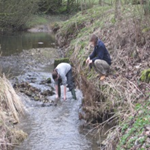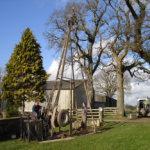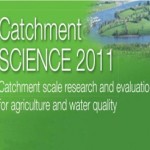Newsletter 1: June 2011
Live data flows from the EdenDTC

Live data from the Newton Rigg outflow can now be viewed online. “The live water quality data from the Newton Rigg outflow marks an important milestone in the EdenDTC project, but also marks an important change in the approach to environmental monitoring…. openness and free access will allow many more people to use the data and hence enhance our understanding of environment.”
Investigating the changing ecology of the River Eden

As part of the effort to improve the water quality of streams entering the Eden, scientists are monitoring the stream ecosystems and will track any changes that occur during the course of the project. Changes in sensitive species will ensure that the impact of mitigation measures can be understood. A monthly monitoring project is now up and running. To catch the start of spring the first samples of diatom – a type of freshwater algae that are very sensitive to nutrients such N and P – have been collected. Being only 0.02mm in length, diatoms are not visible to the naked eye, although the slimy brown surface of rocks in streams reveals their presence. These organisms produce ornate shells made of silica that enables their identification under a microscope. To collect the diatom samples we scrub rocks with a toothbrush –literally cleaning up the Eden. Later in the year we will be adding invertebrate and water plants to the monitoring programme.
Borehole drilling programme in the EdenDTC catchments

During February and March 2011 a drilling programme was completed in the Pow and Newby subcatchments as part of the EdenDTC project. At 21 locations across these two catchments, investigative boreholes were drilled into the superficial Quaternary deposits and core material collected for subsequent analysis. Information from this programme has contributed to the development of conceptual models for both catchments, for example highlighting the potential importance of water-saturated sand lenses within the Quaternary deposits. Piezometers installed to between 2 and 20 metres depth in the drift across the Pow and Newby catchments will be monitored to produce groundwater hydrographs. In combination with streamflow and precipitation data, these hydrographs will provide insight into the hydrological processes operating within the catchments. Samples for water quality analysis will be collected from these piezometers. These samples will focus on detecting changes in shallow groundwater quality resulting from measures implemented as part of the DTC project. Such changes could have implications for the water quality of recharge to the major aquifers underlying both catchments, and also for surface water quality where groundwater – surface water interactions are significant. The drilling programme has also delivered additional benefits to the EdenDTC project. Collaboration with BGS, which has conducted a parallel drilling project examining the heterogeneity of the drift deposits, has been strengthened, and successful collaboration with key farmers in the catchments has been established. The first elements of a research facility focussing on shallow groundwater systems have been installed. Finally, an independently-funded PhD student will begin research focussed on geophysical characterisation of shallow superficial deposits in the Pow catchment during Spring 2011
Catchment Science 2011

An international conference aimed at scientists, policy makers, farmers and land managers. Jointly hosted by the Irish Agriculture Catchment Programme (Teagasc/DAFF) and the UK Demonstration Test Catchment Projects (Defra/EA). Full details can be found at http://www.teagasc.ie/agcatchments/catchmentscience.asp